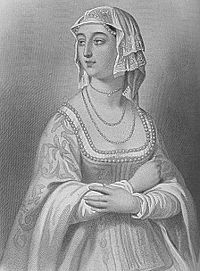Margaret of Anjou
| Margaret of Anjou | ||
|---|---|---|
| Queen consort of England | ||

| ||
| A Victorian imaginary portrait | ||
| Born | March 23, 1429 | |
| Duchy of Lorraine | ||
| Died | August 25 , 1482 | |
| Anjou | ||
| Buried | Anjou | |
| Consort | April 23, 1445 - May 21, 1471 | |
| Consort to | Henry VI | |
| Issue | Edward, Prince of Wales | |
| Royal House | Lancaster | |
| Father | René I of Naples | |
| Mother | Isabella, Duchess of Lorraine | |
Margaret of Anjou (Marguerite d'Anjou, March 23, 1429 – August 25, 1482) was the Queen consort of Henry VI of England from 1445 to 1471, and led the Lancastrian contingent, in the Wars of the Roses.
Margaret was born in the duchy of Lorraine, an Imperial fief east of France that was ruled by the cadet branch of the French kings, the house of Anjou. Margaret was the daughter of Rene I of Naples, Duke of Anjou, King of Naples and Sicily and Isabella, Duchess of Lorraine in her own right. Margaret married King Henry VI, who was eight years her senior, on April 23, 1445, at Titchfield in Hampshire.
Henry, who had more interest in religion and learning than in military matters, was not a successful king. He had reigned since he was a few months old and his actions had been controlled by regents. When he married Margaret, his mental condition was already unstable, and by the time their only son, Edward of Westminster, was born, on October 13, 1453, he had suffered a complete mental breakdown. Rumours were rife that he was incapable of fathering a child and that the new Prince of Wales was the result of an adulterous liaison on Margaret's part.
Margaret seems to have been quite mild-mannered until her husband was threatened with deposition by the ambitious Richard, Duke of York. With the king captured, Margaret managed to escape, and immediately began raising an army in Wales and the north of England, where she was assisted by Henry's half-brother, Jasper Tudor. In 1459, hostilities resumed at the battle of Blore Heath, where Margaret is said to have witnessed her commander, James Touchet, Lord Audley defeated by a Yorkist army under Richard Neville.
Moving her headquarters to York, she gained a major success at the Battle of Wakefield on December 30, 1460, when the combined armies of the Duke of York and the Earl of Salisbury were destroyed. Margaret had both beheaded, and ordered their heads displayed on the gates of the city of York. She followed up with a victory at St Albans on 22 February 1461, at which she defeated the Yorkist forces of Richard Neville, Earl of Warwick, and recaptured her husband.
On March 4, 1461, the Lancastrian army was beaten at the Battle of Towton by the son of the late Duke of York, Edward IV of England, who deposed King Henry and proclaimed himself king. Margaret was determined to win back her son's inheritance, and fled with him into Wales and later Scotland. Finding her way to France, she made an ally of King Louis XI of France, and at his instigation she allowed an approach from Edward's former supporter, Richard Neville, Earl of Warwick, who had fallen out with his former friend and was now seeking revenge for the loss of his political influence. Warwick's daughter, Anne Neville, was married to Margaret's son, Edward, Prince of Wales, in order to cement the alliance, and Margaret insisted that Warwick return to England to prove himself, before she followed. He did so, restoring Henry VI briefly to the throne towards the end of 1470.
By the time Margaret, her son and daughter-in-law were ready to follow Warwick back to England, however, he had been defeated and killed by the returning King Edward IV, and Margaret was forced to lead her own army at the Battle of Tewkesbury in 1471, at which they were defeated and her son was killed. Over the previous ten years, she had gained a reputation for aggression and ruthlessness, but now she was a broken spirit, imprisoned at both Wallingford Castle and in the Tower of London until ransomed by the French king in 1478. She died on August 25, 1482, in Anjou, where she was buried.
Further reading
- Maurer, Helen E. Margaret of Anjou: Queenship and Power in Late Medieval England. Boydell Press, 2003.
| Preceded by: Catherine of Valois |
Queen Consort of England 23 April, 1445 - 4 March, 1471 |
Succeeded by: Elizabeth Woodville |
Credits
New World Encyclopedia writers and editors rewrote and completed the Wikipedia article in accordance with New World Encyclopedia standards. This article abides by terms of the Creative Commons CC-by-sa 3.0 License (CC-by-sa), which may be used and disseminated with proper attribution. Credit is due under the terms of this license that can reference both the New World Encyclopedia contributors and the selfless volunteer contributors of the Wikimedia Foundation. To cite this article click here for a list of acceptable citing formats.The history of earlier contributions by wikipedians is accessible to researchers here:
The history of this article since it was imported to New World Encyclopedia:
Note: Some restrictions may apply to use of individual images which are separately licensed.